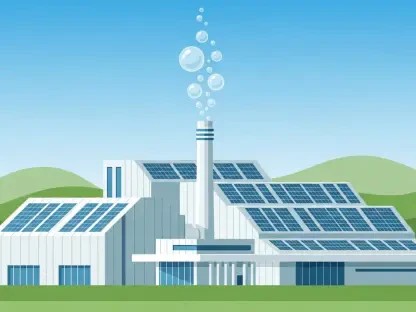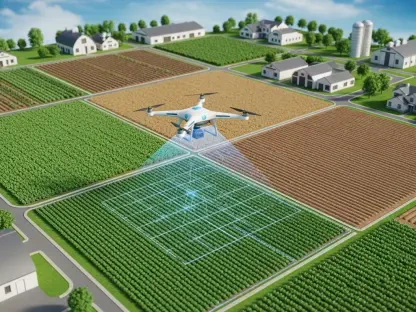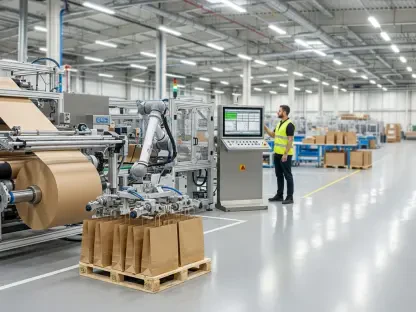America’s railroads, which handle a staggering 40% of the nation’s freight, stand at a critical juncture where the past threatens to derail the future, as the very tracks underpinning cutting-edge logistics—powered by artificial intelligence and precision scheduling—are mired in 19th-century design. These tracks rely on outdated materials and systems that crumble under modern demands. This profound mismatch between ambitious operational goals and aging infrastructure costs billions annually, triggers widespread delays, and undermines the nation’s economic competitiveness. Far beyond a mere technical hurdle, the urgent need for modernization emerges as a national imperative, demanding immediate attention and action. As freight volumes soar and global rivals advance, the time to rebuild the backbone of American commerce is now, before the consequences of inaction ripple through supply chains and markets alike, leaving the country struggling to keep pace in an increasingly connected world.
Bridging the Divide Between Vision and Reality
The chasm between the aspirations of modern railroad operations and the reality of decaying infrastructure is impossible to ignore. Major carriers like BNSF and Union Pacific allocate billions each year to maintenance, yet much of this investment merely patches up failing components rather than driving innovation or expanding capacity. Advanced technologies such as AI-driven logistics and precision-scheduled railroading aim for efficiency and speed, but they falter when tracks and ties cannot withstand the strain. This persistent divide results in frequent service interruptions, escalating repair costs, and a frustrating inability to meet customer expectations. The financial burden of maintaining antiquated systems diverts funds from strategic growth, trapping the industry in a cycle of short-term fixes instead of long-term progress, while the broader economy feels the weight of delayed goods and disrupted timelines.
Beyond the balance sheets, this operational-infrastructure gap reveals a deeper systemic flaw in how the rail network functions. Every breakdown or unplanned outage cascades through the supply chain, affecting industries reliant on timely deliveries, from agriculture to manufacturing. The inability to predict or prevent failures erodes trust in rail as a reliable transport mode, pushing shippers toward costlier or less sustainable alternatives like trucking. Meanwhile, the pressure to maintain aging tracks consumes labor and resources, leaving little room to adopt emerging technologies that could revolutionize freight movement. As global trade accelerates, this disconnect risks positioning American railroads as outdated relics, unable to compete with modernized systems abroad. Addressing this divide isn’t just about fixing tracks—it’s about reimagining a foundation sturdy enough to support the ambitions of a digital era.
Unpacking the Flaws of Outdated Materials
At the core of the railroad crisis lies a troubling dependence on traditional materials like wooden ties, once a practical solution in an era of abundant timber. With old-growth forests long depleted, today’s faster-growing wood lacks the resilience of its predecessors, often deteriorating in just 8 to 15 years, particularly under harsh environmental stress. Even chemical treatments to extend lifespan fall short against relentless decay, forcing constant replacements that inflate costs and disrupt service schedules. This cycle of failure isn’t merely inconvenient; it represents an unsustainable drain on resources, as railroads grapple with sourcing quality timber while facing mounting expenses. The stark reality is that clinging to wood as a primary material no longer aligns with the durability or efficiency demanded by contemporary freight operations.
The limitations of wooden ties extend beyond their physical shortcomings to broader operational challenges that compound the issue. Each replacement means taking tracks out of service, causing delays that ripple across the network and frustrate shippers expecting reliability. The variability in wood quality further complicates maintenance planning, as ties sourced from different regions or species degrade at unpredictable rates, making standardized solutions elusive. Financially, the repeated investment in a material with such a short lifespan diverts capital from innovation, locking the industry into a reactive rather than proactive stance. As modern logistics demand consistency and resilience, the inherent flaws of traditional materials stand as a glaring obstacle, underscoring the pressing need for alternatives that can withstand the rigors of today’s rail demands without constant intervention.
Facing Nature’s Toll on Rail Networks
Environmental challenges pose a formidable threat to America’s already strained railroad infrastructure, exacerbating the wear on outdated systems. In regions like the Southeast and coastal zones, high humidity, intense heat, and insect infestations rapidly degrade materials like wood, slashing their usable life and necessitating frequent repairs. Extreme weather events—ranging from hurricanes to heatwaves—add another layer of stress, damaging tracks and disrupting service with increasing regularity. These geographic disparities make uniform maintenance nearly impossible, as solutions effective in one area often fail in another. The result is a patchwork of vulnerabilities that lead to unexpected outages, undermining the reliability of the entire network and amplifying the risk of costly incidents like derailments, which account for over half of all rail accidents.
The impact of these environmental pressures reverberates far beyond localized damage, creating systemic inefficiencies that challenge the industry’s stability. Track failures driven by weather and regional conditions contribute to significant delays, slowing the movement of goods and inflating operational costs through overtime labor and emergency responses. Such disruptions also strain relationships with shippers, who rely on predictable schedules to manage their own supply chains, often turning to less efficient transport options when rail falters. Moreover, the unpredictability of environmental degradation hinders long-term planning, as railroads struggle to allocate resources effectively across diverse climates and terrains. With climate patterns growing more erratic, the need for infrastructure resilient to nature’s challenges becomes not just a practical concern but a strategic necessity to safeguard the flow of commerce across the nation.
Counting the Cost to Economy and Efficiency
The economic fallout from outdated rail infrastructure casts a long shadow over both the industry and the nation’s broader financial health. Persistent delays from failing tracks drag down service metrics, inflate labor expenses through overtime and emergency repairs, and directly impact the quarterly earnings of major rail operators. Resources that could fuel technological advancements or network expansion are instead consumed by the Sisyphean task of maintaining crumbling systems. As freight volumes continue to climb, this inefficiency translates into higher transportation costs embedded in goods, ultimately burdening consumers and businesses alike. The inability to keep pace with demand not only hampers rail companies but also weakens the economic engine that depends on seamless logistics to thrive in a competitive market.
Operationally, the struggles are equally daunting, as outdated infrastructure undermines every facet of railroad performance. Equipment sits idle during track repairs, crew productivity suffers from unpredictable schedules, and overall network velocity slows to a crawl, creating bottlenecks that snarl supply chains. These issues are compounded by environmental stressors that amplify the frequency of failures, leaving little margin for error in an industry where precision is paramount. The ripple effects extend to interconnected sectors, from retail to raw materials, where delayed shipments disrupt production timelines and erode market confidence. With the stakes so high, the current state of rail infrastructure isn’t merely a logistical problem—it’s a barrier to economic stability, demanding urgent investment in solutions that can restore reliability and efficiency to a critical national asset.
Innovating with Durable Composite Alternatives
A promising path forward emerges with the advent of composite materials, poised to revolutionize railroad infrastructure with their remarkable durability and efficiency. Unlike wooden ties that falter within a decade under tough conditions, composites boast a lifespan of up to 50 years, offering a long-term solution to the cycle of constant replacements. Crafted from recycled plastics, these materials simplify supply chains by reducing reliance on variable natural resources, while large-scale manufacturing drives down costs over time. The economic rationale for adopting composites grows stronger each day, mirroring transformative shifts seen in industries like renewable energy with solar panels and electric vehicles. This isn’t just a stopgap measure—it’s a strategic investment in a future where rail can meet modern demands without breaking the bank.
The appeal of composites extends beyond durability to practical benefits that could reshape railroad operations for the better. Their consistent quality eliminates the unpredictability of wood, enabling standardized maintenance practices that save time and reduce errors. Additionally, their lighter weight and resistance to environmental decay mean fewer service interruptions, allowing tracks to remain operational even in challenging climates. This reliability translates into tangible savings, as reduced downtime and emergency repairs free up capital for innovation and expansion. While the upfront costs of transitioning to composites may seem daunting, the long-term financial and operational gains present a compelling case, positioning these materials as a cornerstone of a modernized rail network capable of supporting the nation’s growing freight needs with confidence.
Blending New Tech with Legacy Systems
Modernizing rail infrastructure doesn’t call for a complete overhaul but rather a thoughtful integration of new solutions with existing frameworks. Composite materials must be compatible with legacy tracks, a complex challenge that engineering teams are addressing through rigorous field testing across diverse conditions. Ensuring seamless functionality involves adapting installation methods and verifying performance under real-world stresses, from heavy freight loads to extreme weather. This phased approach minimizes disruption to current operations, allowing railroads to upgrade incrementally without sacrificing service continuity. The focus on compatibility reflects a pragmatic strategy, balancing the urgency of modernization with the practicalities of maintaining a vast, interconnected network that cannot afford prolonged downtime.
The transition to modern materials also reshapes workforce dynamics, necessitating adaptation while offering significant upsides for rail employees. Workers accustomed to traditional methods will require training in new installation and maintenance techniques tailored to composites, a shift that demands investment in education and skill development. However, the benefits are substantial—fewer emergency repairs mean reduced exposure to hazardous conditions, while predictable maintenance schedules improve job planning and morale. Safety gains are another critical advantage, as durable materials lower the risk of track failures that endanger crews and cargo alike. This evolution in workforce needs underscores that modernization is not just about infrastructure but also about empowering the people who keep railroads running, ensuring they are equipped to handle the demands of a transformed industry with confidence and competence.
Securing a Competitive Edge on the Global Stage
The implications of modernizing rail infrastructure stretch far beyond national borders, touching on America’s ability to remain a leader in global trade. With freight volumes expected to surge by 50% by 2050, efficient railroads are essential for keeping transportation costs low and ensuring American goods remain competitive in international markets. Delays and inefficiencies driven by outdated tracks inflate expenses that ripple through supply chains, ultimately raising prices for consumers and weakening the appeal of U.S. products abroad. Meanwhile, other nations are rapidly upgrading their logistics networks, leveraging advanced materials and technology to gain an edge. Without swift action, the risk of falling behind looms large, threatening to cede market dominance to rivals better equipped for the demands of modern commerce.
This competitive pressure transforms rail modernization into a strategic imperative, not merely a technical necessity. A robust, reliable freight system underpins economic stability, supporting industries from agriculture to manufacturing that rely on timely delivery to meet global demand. Failing to invest in infrastructure now could mean losing ground in trade negotiations and partnerships, as international buyers turn to more dependable suppliers. The urgency is compounded by the interconnected nature of today’s economy, where a single delay can disrupt entire production cycles across continents. Embracing durable solutions like composites and prioritizing infrastructure upgrades positions the nation to not only meet future freight growth but also to lead in efficiency and innovation, securing a pivotal role in shaping the global logistics landscape for decades to come.
Charting the Path to a Stronger Rail Future
Looking back, the journey to address the rail infrastructure crisis revealed a stark reality: systems rooted in a bygone era struggled to support the ambitions of a digital age, costing billions and risking economic setbacks. Environmental challenges and outdated materials like wooden ties compounded the strain, while operational inefficiencies rippled through supply chains. Yet, amidst these hurdles, solutions emerged with composite materials promising durability and cost savings, alongside strategies for smart integration and workforce adaptation. Reflecting on these insights, the industry stood at a pivotal moment where inaction was no longer an option if global competitiveness was to be preserved.
Moving forward, the focus must shift to actionable steps that build on past lessons. Scaling production of modern materials to reduce costs, accelerating product development to match the affordability of traditional options within a few years, and fostering trust in suppliers through consistent performance standards are essential pillars. Collaboration between rail operators, engineers, and policymakers can drive this transformation, ensuring investments target the most vulnerable regions first while prioritizing long-term resilience. By committing to these priorities, the rail sector can evolve into a reliable foundation for economic growth, equipped to handle soaring freight demands and stand firm against international competition, securing a legacy of innovation over obsolescence.









